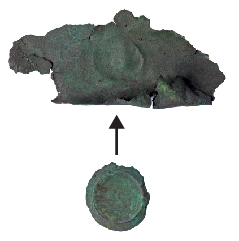Court-St-Etienne La Ferme Rouge Tombelle 4
Tombelle 4 is one of the barrows found at the exceptional elite cemetery of Court-St-Etienne[1]. This particular barrow was relatively large, some 22 m in diameter, and likely dates quite early in the Iron Age (roughly the 8th century BC).[2] It was excavated over a century ago by C. Dens in 1902,[3] so we have limited information regarding its excavation and its contents.
What we do know is that this mound yielded a ceramic urn filled with cremation remains and an accessory vessel, several bronze phalerae (a type of horse-gear decoration) and yoke decorations, a concretion of iron, an iron fragment with textile imprint on it and fragments of a small bronze bowl.[4] I examined some of the finds from this barrow in the Royal Museums of Art and History in Brussels during my PhD, and published the full results in my Catalogue.

In the past, the cremation remains from this barrow were identified as those of a female individual[5], though it is unclear whether this is accurate. Analysis of cremated remains is a relatively recently developed field, and experience tells us that any anthropological analysis performed prior to the 1990s should be considered suspect.[6] In any case, the deceased was cremated wearing a bronze bracelet.
If this barrow was the grave of a woman, then it is intriguing that she was interred with the remains of elaborate horse-gear and yoke components. These include two bronze phalerae that take the shape of small circles with bent edges and a loop on the back. The concretion of iron proved to be a complex chest ornament for a horse, made up of at least six iron rings with dangling, triangular pendants attached.[7] It would likely have decorated the chest-strap used to attach the yoke. Two bronze ovals and a fragment of a third are yoke rosettes and would have decorated the wooden yoke.


There are also several fragments of a bronze bowl, both the center part fragments that appear to form some kind of rim with a hammered, finished edge. Interestingly, the largest fragment has a round imprint in the center, which appears to be from one of the phalerae pressing into the bronze sheet post-depositionally. This tells us that these finds were buried pressed closely together, perhaps in the urn or wrapped in textiles. The latter seems plausible given the presence of an iron fragment with textile imprint. This textile was likely used to wrap objects during the funerary ritual, as any garments worn by the deceased would not have survived cremation. Moreover, the use of textiles for wrapping objects is a well-attested feature in certain elite burials.
References
[1] Mariën, M.-E., 1958. Trouvailles du Champ d’Urnes et des Tombelles hallstattiennes de Court-SaintEtienne (Monographies d’Archéologie Nationale 1), Brussels: Musées Royaux d’Art et d’Histoire.
[2] Kossack, G., 1954. Pferdegeschirr aus Gräbern der älteren Hallstattzeit Bayerns, Jahrbuch des Römisch Germanischen Zentralmuseums Mainz I, 111–178.
Mariën, M.-E., 1958. Trouvailles du Champ d’Urnes et des Tombelles hallstattiennes de Court-SaintEtienne (Monographies d’Archéologie Nationale 1), Brussels: Musées Royaux d’Art et d’Histoire.
Trachsel, M.,2004, 369. Untersuchungen zur relativen und absoluten Chronologie der Halstattzeit (Universitätsforschungen zur prähistorischen Archäologie 104), Bonn: Dr. Rudolf Habelt GMBH.
[3] Dens, C., 1903. Sépultures a incineration du Premier Age du Fer dans la Région D’Ottignies, Annales de la Société d’Archéologie de Bruxelles 17, 139–162.
[4] Mariën, M.-E., 1958, 128. Trouvailles du Champ d’Urnes et des Tombelles hallstattiennes de Court-SaintEtienne (Monographies d’Archéologie Nationale 1), Brussels: Musées Royaux d’Art et d’Histoire.
[5] Mariën, M.-E., 1958, 142. Trouvailles du Champ d’Urnes et des Tombelles hallstattiennes de Court-SaintEtienne (Monographies d’Archéologie Nationale 1), Brussels: Musées Royaux d’Art et d’Histoire.
[6] Van der Vaart-Verschoof, S., 2017a, section 2.2.3.3. Fragmenting the Chieftain. A practice-based study of Early Iron Age Hallstatt C elite burials in the Low Countries, Leiden: Sidestone Press (=PALMA 15A).
[7] Mariën, M.-E., 1958,132–4, fig. 23. Trouvailles du Champ d’Urnes et des Tombelles hallstattiennes de Court-SaintEtienne (Monographies d’Archéologie Nationale 1), Brussels: Musées Royaux d’Art et d’Histoire.
Van der Vaart-Verschoof, S., 2017b. Fragmenting the Chieftain Late Bronze and Early Iron Age elite burials in the Low Countries, Leiden: Sidestone Press (=PALMA 15B).